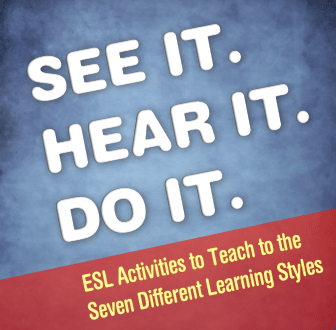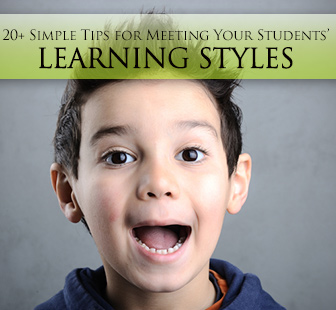See it, Hear it, Do it: ESL Activities to Teach to the Seven Different Learning Styles


What difference does it make when we teach to the different learning styles? How can we determine what learning styles our students have? Teachers have been asking themselves these questions for years, and the best teachers will continue to ask them looking for better and better answers. These are valid questions and ones worth looking into, but sometimes their answers might be simpler than you might think. Here are some quick tips you can use to make sure you teach to your students’ learning styles – whatever they are!

Visual learners often do well in school because most teachers know how important it is to write things on the board. These learners see things and absorb the information into their minds. For these learners, what they see is key. Here are some ways to meet the needs of these students.
Bodily or kinesthetic learners can be easily overlooked in the classroom. Traditional classrooms don’t necessarily encourage students to get up and move in the middle of class. However, kinesthetic learners can really flourish in the ESL classroom if you take the time to plan the right activities.
I’m not one to advocate heavy lecture in English classes, but that doesn’t’ mean you can’t explain new concepts from the front of the class. Your aural learners will absorb information best when they hear you explain a new concept and will also benefit from hearing a native speaker use English.
Verbal or linguistic learners will naturally excel in language classes, and your ESL class will be no exception. You will probably have no problem identifying these students who pick up on language with little to no effort and may sound the most like native speakers. Linguistic learners will connect through any language based activities, which is what ESL class is all about, so you won’t need special accommodations for them unless it is to challenge them.
Logical and mathematical learners are just what they sound like. They learn best through logical and organized methods or through mathematical and abstract concepts. You can include specific activities in your ESL class to reach these hard science lovers.
Though the goal of every ESL class is English fluency, some students will need some independent work to get there. These students who learn best on their own may find a highly communicative class more challenging than other students. Here are some ways to reach these members of your class and decrease their potential stress.
Social or interpersonal learners learn best when they interact with other people. This may be the easiest type of learner to target in the ESL classroom since most teachers use group activities on a regular basis anyway. Here are some ways you can be sure to reach these learners.
For some people, one style is clearly dominant. For others, they will learn equally well through two or three styles. Regardless, teachers who include activities geared toward every learning style will find their students become successful language learners and, eventually, fluent speakers of English.
What language style do you find it easiest to cater to in your ESL class? Which is most difficult?